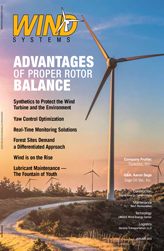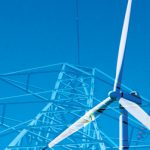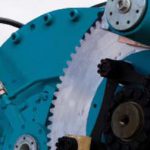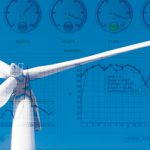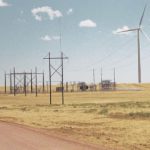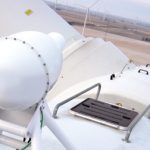OEM’s, service companies and end-users have an abundance of gear lubricant products available for use in wind-turbine gearboxes. Many OEM factory-fill products come with two- to five-year warranty periods. Pricing is usually the main concern to the customer when it’s time to choose a lubricant once the warranty period has ended or the factory-fill lubricant has reached the end of its useful life. What should be of concern is the performance level of the lubricant and how it relates to the wind turbine gearbox and more importantly, how it protects the environment the wind turbine/farm they reside in In addition, a lubricant company should also provide all the necessary support such as on-site inspection, free condition monitoring and advice on add-on components such as lubricant filtration systems, wireless monitoring devices and mechanical insurance, whether they provide these services themselves or through a contracted service company.
Safety and the Environment
Unexpected lightning strikes, generator set malfunctions and other mechanical and electrical system malfunctions have the potential to ignite lubricants that are on board a wind turbine’s nacelle. This potential is elevated when standard mineral oil-based products are used. Synthetic wind turbine lubricant technologies such as Total’s Carter SH 320, Carter SE 320, and Carter SY 320 help reduce the risk of fire and explosion when system malfunctions occur. They should be strongly considered where long fluid life, safety and environmental protection are paramount.
In Europe and North America, Fire protection agencies such as CFPA E & NFPA have recently added wind turbine and outbuilding fire protection standards. These standards are the CFPA E No 22:2010F “Wind Turbine Fire Protection Guidelines” and NFPA 850 std., titled “Recommended Practice for Fire Protection for Electric Generating Plants and High Voltage Direct Current Converter Stations,” 2010 Edition. These codes provide detailed recommendations for wind turbine generating facilities fire protection requirements.
A single turbine may contain up to 200 gallons of oil. The transformer at the base of each turbine may contain another 500 gallons of oil. In rural areas even a spark can easily develop into a large fire before discovery is made and fire-fighting can begin. Damage from fire accounts for up to 20 percent of wind power insurance claims.
Leading Causes of Turbine Fires
Lightning strikes are the leading cause of wind turbine fires. This is primarily brought about by their exposed and often high-altitude location and the height of the structure — turbines are now being built that are up to 320 feet tall.
Mechanical failure or electrical malfunction also accounts for a significant percentage of fires that can be fueled by hydraulic fluid and lubricants in the nacelle, which itself are constructed from highly-flammable resin and glass fiber. Internal insulation in the nacelle, which can become contaminated by oil deposits, adds to the fuel load.
Electrical equipment is another high-risk area. Capacitors, transformers, generators, electrical controls, and transmission equipment all have the potential to catch fire, as do Supervisory Control and Data Acquisition (SCADA) systems. There is also the risk of fire due to loose or broken electrical connections or the overloading of electrical circuits.
Braking systems also pose a particularly high fire risk. Overheating can cause hot fragments of the disc brake material to break off, rupturing hydraulic hoses and resulting in highly combustible hydraulic fluid being expelled under pressure and coming into contact with the hot disc brake fragments. Hydraulic pumps and connections have also been known to fail, allowing the fluid to erupt into flames when it comes into contact with a hot surface.
Synthetics based on PAO, PAO/ester, Polyolester and Polyalkylenglycols provide high flash points and low volatility, which provide a wider margin of safety in regard to fire protection. The following table (Table 1) illustrates this increased level of protection for both gear fluids and hydraulic fluids.
Environmental Protection
Total Specialties believe that we should all strive toward minimizing the negative impact we have on our environment in regard to the amount of pollution generated in our day-to-day lives, whether at work or at home. We proudly support and specify the use of our biodegradable lubricants whenever possible. Total defines biodegradation as the chemical breakdown or transformation of a substance caused by organisms and their enzymes. Further, in regard to what defines a biodegradable lubricant, we utilize either ASTM D 5864 and/or OECD 301 B, which are standard test methods for the determination of aerobic-aquatic biodegradation of a lubricant, which specifically defines degradation of a lubricant from 60 percent to 95 percent within nine to 28 days.
Biodegradable Terminology
Primary biodegradation — is defined as a minimal modification of a substance by microorganisms that cause a change in some measurable property of the substance.
Ultimate biodegradation — is the degradation achieved when a substance is totally utilized bymicroorganisms resulting in the production of carbon dioxide, methane, water, mineral salts, and new microbial cellular constituents. This term usually refers to vegetable oil-based products
Readily biodegradable — Using the ASTM test method D 5864 or OECD 301 B, 60 percent or more of the test material carbon must be converted to CO2 in 28 days. Usually associated with lubricants that are glycol or ester-based whether synthesized from renewable resources (Oleochemical) or synthetic esters, (class HEES) such as Total Biohydran SE-series.
Inherently biodegradable — is a classification of chemicals for which there is unequivocal evidence of biodegradation (primary or ultimate) in any test of biodegradability. This term is usually associated with mineral oil-based products due to their low degree of biodegradation in ASTM D 5864 or OECD 301 B (Typically less than 40 percent). Products that are classified as inherently biodegradable are also pollutants and if disposed of in the environment are subject to fines, clean-up regulations, and long-term remediation.
Mineral-based formulae are not biodegradable. Applications where biodegradability is of importance, such as offshore service or areas mandated by governmental, state or local law, mandate the use of esters — specifically polyolesters (such as Total Carter SE 320) and polyalkyleneglycols (such as Total Carter SY 320).
Synthetic Lubricant Overview
Synthetic chemistries provide energy efficiency and energy conservation which are of major concern today. Synthetic lubricants formulated for general industrial applications typically utilize some combination of PAO (polyaplhaolefin), Diester, Polyolester, alkylnaphthalene, and PAG (polyalkyleneglycol)-oil soluble type. These synthetic basestock chemistries bring certain attributes that can maximize performance in relation to the mechanical components operation. Synthetics provide enhanced thermal-oxidative resistance, improved lubricity, heat dissipation, and wider operating temperature range, when compared to mineral oil-based products. The use of synthetics provides performance-level gains over longer periods of time as compared to mineral oil-based products. For example, a typical ISO 320 mineral oil-based product lasts 2-3 years in most wind turbine applications. Synthetic basestocks such as polyalphaolefins (PAO), due to their “non-polar” nature, are excellent at separating from water, which is attractive in many applications where water has the potential to migrate into the lubricant — such as rotary screw compression applications and Industrial gearbox operating in humid conditions. Esters, such as diesters, triesters and especially polyolesters, due to their polar nature and molecular bonding strength, provide excellent thermal-oxidative stability, which is very attractive in high heat, closed system applications such as aeroderivative turbines. Of special interest to the formulator, PAO’s and esters have opposing reactions in regard to compatibility properties in relation to most commonly used elastomers and seals. A balance between the two can provide a compatibility characteristic that is favorable to the applications seals, gaskets, and coatings especially in elevated temperatures and pressures. Some formulations may also contain low amounts of high molecular weight “thickeners” such as polyisobutylene (PIB), polyalkyl methacrylates (PAMA), or polymeric esters in order to build viscosity to the required ISO level.
In regard to synthetics, the standard basestock chemistry that has the most wide spread usage in wind turbine gear applications today is PAO with addition of polyolester. The addition of polyolester, usually a TMP (trimethyolpropane)-type, is mainly an aid for additive solubility, contaminant dispersion and in combination with PAO provides the required compatibility profile. This PAO/ester-blend utilizes a combination of low molecular weight and high molecular weight polyalphaolefin species. Since they contain high molecular weight polyalphaolefins, they do not require polymeric thickeners such as some mineral oil-based products. Shear rates are very low for products that use high molecular weight PAO. For instance, PAO 40 when blended with PAO 4 showed to have only a 0.5 percent viscosity loss in the KRL 20-hour tapered bearing shear test. Comparatively, certain polyalkylmethacrylates blended with PAO 4 can lose up to approximately 6 percent.
Typical additive chemistry for wind turbine gear lubricant utilizes extreme pressure and anti-wear additive package that usually contains some combination of sulfur, phosphorus and boron along with antioxidants, anticorrosives and defoamants. The PAO basestocks offer low pour point, high flash point, in addition to excellent thermal-oxidative stability, shear stability, and demulsibility properties which are all considered paramount in regard to performance properties in typical wind turbine service. PAO’s molecular structure also provides a high inherent viscosity index. The high viscosity index is directly related to the molecular chain structure which is “comb-like.” Though its structure resembles a hydrocarbon (since it is synthesized) it contains no wax or other undesirable chemicals that are particularly found in group one and group two mineral oils. Typical viscosity index for an ISO grade 320 PAO-based product is in the range of 145 to 160. The high viscosity index provides wide operating temperature range and indicates the amount of “molecular density load” or hydrodynamic film provided between metal surfaces under elevated pressure and temperature. The molecular structure of polyalphaolefins provides very low order of volatility, especially with the high molecular species. This low order of volatility relates to low levels of fluid loss in high-temperature, high-pressure applications which lessons the call for “top-off” or “make-up” oil. For comparison, low molecular weight polyalphaolefin has approximately a 12 percent weight loss in volatility (Noack) testing. Whereas, the equivalent viscosity mineral oil yields 14 to 23 percent weight loss. Another detriment of using mineral oil based products is the deleterious byproducts from oxidative breakdown that they leave behind in lubrication systems and mechanical parts. These byproducts are usually in the form of varnish and/or coke. These remnants will eventually be solubilized by the ester contained in the PAO formulation. The inherent low pour points of PAO/ester gear formulations offer “clean operation” and energy efficiency at low temperature start-ups and during standard operations. Of importance, most well-formulated PAO-based products do not use viscosity improvers in the formulation. Comparatively, most mineral oil-based formulations utilize viscosity improvers. As stated earlier, wind turbine gear formulations require a high degree of shear stability which most viscosity improvers cannot provide.
PAG’s and POE’s, such as Total’s Carter SY 320 and Carter SE 320 respectively, provide excellent thermal stability, low order of volatility, and high flash points. Their molecular structures have excellent effect on lubricity, solvency, and biodegradability. This is very attractive since it effectively lowers the carbon footprint in regard to its manufacturing process. Many polyolesters are manufactured using vegetable-derived renewable content some high as 85 percent. Both polyalkyleneglycols and polyolesters attribute their high level of polarity to the inclusion of oxygen in the hydrocarbon molecular structure. As far as physical properties go, they have much higher specific heat and thermal conductivity profiles as compared to mineral oil. Specific heat and thermal conductivity are a measure of how well a lubricant absorbs and dissipates heat. They have the ability to carry more heat away from the friction sites in a gearbox such as bearing surfaces and at the gear-teeth contact site.
Coefficient of friction and thermal conductivity properties improve with this type of molecular structure. Coefficient of friction is the lubricants ability to improve mechanical efficiency through minimizing the friction (or wear) between moving parts. Thermal conductivity is a measure of the lubricant’s ability to absorb heat than dissipate the heat away from the mechanical friction sites such as the gear teeth and bearings found in wind turbine gearboxes. Both properties have a positive impact on operating temperature. It is well known that cooler running mechanical components last longer.
Synthetic lubricants are the clear choice for protecting not only the mechanical components of a wind turbine but also our environment.



















